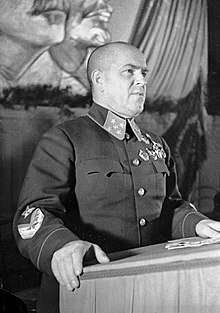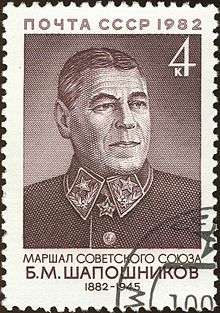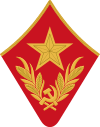Ranks and insignia of the Red Army and Navy 1940–1943
The ranks and rank insignia of the Red Army and Red Navy between 1940 and 1943 were characterised by continuing reforms to the Soviet armed forces in the period immediately before Operation Barbarossa and the war of national survival following it. The Soviet suspicion of rank and rank badges as a bourgeois institution remained, but the increasing experience of Soviet forces, and the massive increase in manpower all played their part, including the creation of a number of new general officer ranks and the reintroduction of permanent enlisted ranks and ratings.

Change of military rank insignia
From May 1940 the introduction of general ranks in the Red Army and flag officer ranks in the Soviet Navy was officially sanctioned, by decree of the Presidium of the Supreme Soviet.[1] The following general officer ranks were introduced with corresponding insignia:
- High level force commanding staff — major general, lieutenant general, colonel general and general of the army
- Artillery commanders — major general of the artillery, lieutenant general of the artillery and colonel general of the artillery
- Air force commanders (including naval aviation) — major general of aviation, lieutenant general of the aviation, and colonel general of aviation
- Armoured corps commanders — major general of the armoured corps, lieutenant general of the armoured corps, and colonel general of the armoured corps
- Communications troops commanders — major general of the communications troops, lieutenant general of the communications troops and colonel general of the communications troops
- Engineer troops commanders — major general of the engineer troops, lieutenant general of the engineer troops and colonel general of the engineer troops
- Commanding staff of other arms and services (including: chemical, railway, transport and military cartography) — major general of the technical troops, lieutenant general of the technical troops, and colonel general of the technical troops
- Leading staff of the commissariat service — major general of the commissariat service, lieutenant general of the commissariat service, and colonel general of the commissariat service
- Flag officers of the Soviet Navy — rear admiral, vice admiral, admiral, and admiral of the fleet
- Generals of the Soviet Navy on coastal service — major general of the coastal service, lieutenant general of the coastal service, and colonel general of the coastal service
- Engineer flag officers of the Soviet Navy — rear admiral engineer, vice admiral engineer, and admiral engineer
On 4 June 1940, the first promotions to the newly established ranks were made. First to be promoted to the rank of army general were Zukov, Meretskov and Tyulenev. The rank insignia that characterized it were as follows:
- Gorget patch: One large star in gold embroidery, on the lower part two round laurel twigs and the hammer & sickle emblem.
- Sleeve: One large star in gold embroidery, red piping, below a red coloured chevron in gold embroidery, surrounded by two gold laurel-twigs with red piping.
The rank of marshal of the Soviet Union, established in September 1935, remained unchanged.[2] What would become a future rank system started to take shape with the promotion of the first Marshal of Artillery in early 1943, with the collar patch of a Marshal but in black.
With the new rank regulations came the reintroduction of the Yefreytor rank to the Army and Air Force and the introduction of new ratings for the Navy: Leading Red Fleet Man (naval services) and Yefreytor (coastal services).
Ranks and rank insignia
The general intention of rejecting traditional rank insignia (as opposed to the epaulettes and shoulder boards of Imperial Russian forces) was maintained. The large gorget patches were modified. The rhombic patches previously used by generals were replaced by one five-pointed golden star. A new emblem, the symbol of a particular branch of service, was added. The general's star remained slightly smaller than the marshal's star.
The small gorget patches, mounted on the tunic (or gymnastyorka), remained unchanged, but they were made in the corps colour and contained an emblem to indicate the branch of service or special appointment. The previously- used gold coloured rank chevrons for general ranks were retained with small modifications.
Corps colours, emblems

The corps colours of 1935 were maintained, with minor changes.
Trouser stripes, gorget rank insignia and cap piping was given to general officers and marshals of the Soviet Union:
- Marshal of the Soviet Union and generic force commanders and commanding generals: deep red trouser stripes
- Artillery and armour generals: black gorgets with red piping and deep red trouser stripes
- Air force: Blue gorgets
- Generals of communication troops, engineer troops, technical troops and the commissariat service: Crimson gorgets
The rank of general of the artillery, of armoured troops, of the air force, of communication troops, of engineer troops, of technical troops and of the commissariat service wore on the gorget the appropriate emblem of their branch of service, special force, or assignment. Corps colour, typical to the branch of service were:
- Infantry: Raspberry
- Artillery and transport troops: Black
- Air force and air defence: Blue
- Cavalry: Dark blue
- Rear services (supply, maintenance, transport, medical, etc.): Dark green
- Ministry of the interior and state security:
- Border troops: Light green
- State security: Blue
- All others: Chestnut-brown
Rank insignia land forces and Air Force 1940–1943
Higher commanders
| Designation | Higher commanders | |||||||||||
|---|---|---|---|---|---|---|---|---|---|---|---|---|
| Rank insignia | Collar |  |
 |
 |
 |
 | ||||||
| Sleeve |  |
 |
 |
 |
 | |||||||
| Rank designation | Marshal of the Soviet Union | General of the Army | Colonel general | Lieutenant general | Major general | |||||||
| (Russian) | (Маршал Советского Союза) | (Генерал армии) | (Генерал-полковник) | (Генерал-лейтенант) | (Генерал-майор) | |||||||
| OF-equivalent | OF10 | OF9 | OF8 | OF7 | OF6 | |||||||
Middle and senior commanders
| Designation | Senior commanders | Middle-level commanders | ||||||
|---|---|---|---|---|---|---|---|---|
| Rank insignia | Coat-collar |  |
 |
 |
 |
 |
 |
 |
| Gymnastjorka | ||||||||
| Sleeve |  |
 |
 |
 |
 |
 |
 | |
| Rank designation | Colonel | Lieutenant colonel | Major | Captain | Senior lieutenant | Lieutenant | Junior lieutenant | |
| (Russian) | (Полковник) | (Подполковник) | (Майор) | (Капитан) | (Старший лейтенант) | (Лейтенант) | (Младший лейтенант) | |
| OF-equivalent | OF5 | OF4 | OF3 | OF2 | OF1 | |||
Junior commanders and enlisted men
| Designation | Junior commanders | Enlisted men | |||||
|---|---|---|---|---|---|---|---|
| Rank insignia | Coat-collar |  |
 |
 |
 |
 |
 |
| Gymnastjorka | |||||||
| Rank designation |
Starshina | Senior sergeant | Sergeant | Junior sergeant | Yefreytor | Red Army man | |
| (Russian) | (Старшина) | (Старший сержант) | (Сержант) | (Младший сержант) | (Ефрейтор) | (Красноармеец) | |
| OR-equivalent | OR8 | OR7 | OR6 | OR5 | OR4 | OR1 | |
Rank insignia of the Soviet Navy 1940–1943
Flag officers
| Designation | Commander in chief, higher commanding flag officers and senior appointments | ||||
|---|---|---|---|---|---|
| Sleeve insignia |  |
 |
 |
 | |
| Rank designation | Admiral of the fleet | Admiral | Vice admiral | Rear admiral | |
| (Russian) | (Адмирал флота) | (Адмирал) | (Вице-адмирал) | (Контр-адмирал) | |
| OF-equivalent | OF9 | OF8 | OF7 | OF6 | |
| coastal services and other branches | |||||
| Rank designation | full General | Colonel general | Lieutenant general | Major general | |
| (Russian) | (Генерал армии) | (Генерал-полковник) | (Генерал-лейтенант) | (Генерал-майор) | |
Naval officers
| Designation | Commanding officers, commanders and sub-unit commanders | ||||||
|---|---|---|---|---|---|---|---|
| Sleeve insignia |  |
 |
 |
 |
 |
 |
 |
| Rank designation | Captain 1st rank | Captain 2nd rank | Captain 3rd rank | Captain lieutenant | Senior lieutenant | Lieutenant | Junior lieutenant |
| (Russian) | (Капитан 1 ранга) | (Капитан 2 ранга) | (Капитан 3 ранга) | (Капитан-лейтенант) | (Старший лейтенант) | (Лейтенант) | (Младший лейтенант) |
| OF-equivalent | OF5 | OF4 | OF3 | OF2 | OF1 | ||
| coastal services and other branches | |||||||
| Rank designation | Colonel | Lieutenant colonel | Major | Captain | Senior lieutenant | Lieutenant | Junior lieutenant |
| (Russian) | Полковник | (Подполковник) | (Майор) | (Капитан) | (Старший лейтенант) | (Лейтенант) | (Млаший лейтенант) |
Lower commanding staff and enlisted ratings
| Designation | Lower commanding staff and specialists | Enlisted men | ||||
|---|---|---|---|---|---|---|
| Sleeve insignia | _Michman1943.png) |
 |
_Squad_Leader.png) |
 |
 |
 |
| Rank designation | Midshipman | Chief Petty Officer |
Petty Officer 1st class |
Petty Officer 2nd class |
Senior red fleet man | Red fleet man |
| (Russian) | (Мичман) | (Главный старшина) | (Старшина 1-й статьи) | (Старшина 2-й статьи) | (Старший краснофлотец) | (Краснофлотец) |
| OR-equivalent | OR8 | OR7 | OR6 | OR5 | OR4 | OR1 |
| coastal services and other branches | ||||||
| Rank designation | Major sergeant | Senior sergeant | Sergeant | Junior sergeant | Senior red fleet man | Red fleet man |
| (Russian) | (Старшина) | (Старший сержант) | (Cержант) | (Младший сержант) | (Старший краснофлотец) | (Краснофлотец) |
The 1940 regulations reinstated ground force-style ranks to the coastal services of the Navy.
See also
- History of Russian military ranks
- Ranks and rank insignia of the Russian armed forces until 1917
- Ranks and rank insignia of the Red Army 1918–1935 and ... 1935–1940
- Ranks and insignia of the Soviet Armed Forces 1943–1955 and ... 1955–1991
- Ranks and rank insignia of the Russian Federation's armed forces 1994–2010
References
- Decree of the "Presidium of the Supreme Soviet" of 7 May 1943
- Disposal by the central executive committee of the Council of People's Commissars, of 22 September 1935